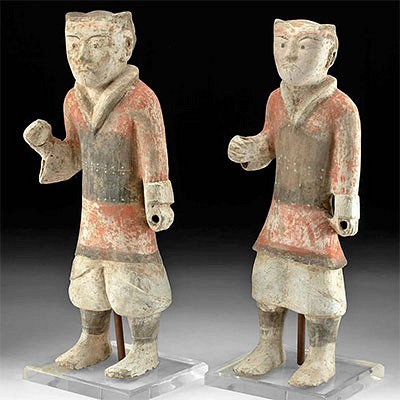Sican Whistling Stirrup Vessel - Sea Lion Form
Lot 109
About Seller
Artemis Fine Arts
686 S Taylor Ave, Ste 106
Louisville, CO 80027
United States
Selling antiquities, ancient and ethnographic art online since 1993, Artemis Gallery specializes in Classical Antiquities (Egyptian, Greek, Roman, Near Eastern), Asian, Pre-Columbian, African / Tribal / Oceanographic art. Our extensive inventory includes pottery, stone, metal, wood, glass and textil...Read more
Categories
Estimate:
$1,500 - $2,250
Absentee vs Live bid
Two ways to bid:
- Leave a max absentee bid and the platform will bid on your behalf up to your maximum bid during the live auction.
- Bid live during the auction and your bids will be submitted real-time to the auctioneer.
Bid Increments
| Price | Bid Increment |
|---|---|
| $0 | $25 |
| $300 | $50 |
| $1,000 | $100 |
| $2,000 | $250 |
| $5,000 | $500 |
| $10,000 | $1,000 |
| $20,000 | $2,500 |
| $50,000 | $5,000 |
| $100,000 | $10,000 |
| $200,000 | $20,000 |
About Auction
By Artemis Fine Arts
May 25, 2023
Set Reminder
2023-05-25 10:00:00
2023-05-25 10:00:00
America/New_York
Bidsquare
Bidsquare : ON-SALE! Antiquities, Pre-Columbian, Ethno, Fine Art
https://www.bidsquare.com/auctions/artemis-gallery/on-sale-antiquities-pre-columbian-ethno-fine-art-12860
ON-SALE Antiquities, Pre-Columbian, Ethno, More! Artemis Fine Arts info@artemisgallery.com
ON-SALE Antiquities, Pre-Columbian, Ethno, More! Artemis Fine Arts info@artemisgallery.com
- Lot Description
Pre-Columbian, North Coast of Peru, Sican / Lambayeque culture, ca. 800 to 1000 CE. A fantastic mold-made whistling stirrup jar in excellent condition. The jar has two bowls, one with a cylindrical body, squared-off top, and narrow, conical spout; the other in the form of a sea lion with its head tilted upwards and its mouth open. The flippers are wonderfully detailed, as are the whiskers, eyes, and small nostrils and ears. When the spout is blown into, sound comes through the mouth. Between the two bowls is a curved strap handle and a round tube. Size: 6.75" L x 3.2" W x 5.5" H (17.1 cm x 8.1 cm x 14 cm)
The people of this culture and others in the area - notably the Moche - would have seen sea lions along the coast. They seem to have associated the animals in some way with human sacrifices, and we know from Moche art that they were ritually hunted. Excavations of the site of Huaca de la Luna uncovered a tomb with a clay effigy of a sea lion and a sea lion canine tooth resting on the body's sternum. Some researchers have suggested that they are associated with humans because of the animals' abilities to live both on land and in the sea, making them occupy a liminal space in the minds of people whose cosmology was ordered around the natural world. Whatever its meaning, this whimsical representation of the animal is a delight to behold.
Provenance: private Colorado Springs, Colorado, USA collection; ex-private Hawaii collection, USA; ex-private Boston, Massachusetts, USA collection; ex-private Hans Juergen Westermann collection, Germany, collected from 1950 to 1960s
All items legal to buy/sell under U.S. Statute covering cultural patrimony Code 2600, CHAPTER 14, and are guaranteed to be as described or your money back.
A Certificate of Authenticity will accompany all winning bids.
We ship worldwide and handle all shipping in-house for your convenience.
#121462Tiny chips from spout, rim, and mouth of animal. Expertly repaired and restored from multiple pieces. This is almost impossible to discern.Condition
- Shipping Info
-
All shipping is handled in-house for your convenience. Your invoice from Artemis Gallery will include shipping calculation instructions. If in doubt, please inquire BEFORE bidding for estimated shipping costs for individual items.
-
- Buyer's Premium



 EUR
EUR CAD
CAD AUD
AUD GBP
GBP MXN
MXN HKD
HKD CNY
CNY MYR
MYR SEK
SEK SGD
SGD CHF
CHF THB
THB


















